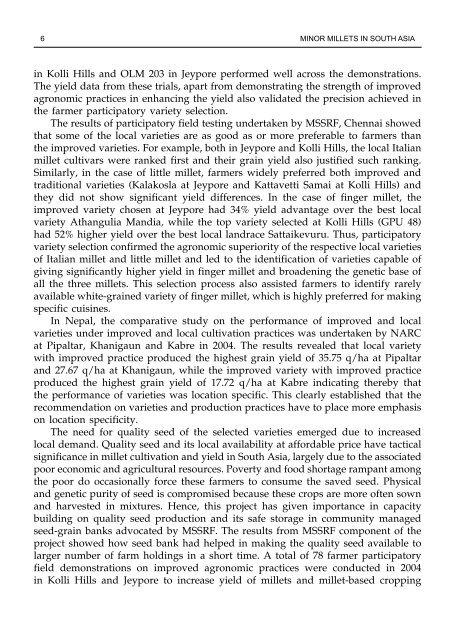Minor millets in South Asia: learnings from IFAD-NUS project in India ...
Minor millets in South Asia: learnings from IFAD-NUS project in India ...
Minor millets in South Asia: learnings from IFAD-NUS project in India ...
Create successful ePaper yourself
Turn your PDF publications into a flip-book with our unique Google optimized e-Paper software.
6 <strong>M<strong>in</strong>or</strong> Millets <strong>in</strong> south AsiA<br />
<strong>in</strong> Kolli Hills and OLM 203 <strong>in</strong> Jeypore performed well across the demonstrations.<br />
The yield data <strong>from</strong> these trials, apart <strong>from</strong> demonstrat<strong>in</strong>g the strength of improved<br />
agronomic practices <strong>in</strong> enhanc<strong>in</strong>g the yield also validated the precision achieved <strong>in</strong><br />
the farmer participatory variety selection.<br />
The results of participatory field test<strong>in</strong>g undertaken by MSSRF, Chennai showed<br />
that some of the local varieties are as good as or more preferable to farmers than<br />
the improved varieties. For example, both <strong>in</strong> Jeypore and Kolli Hills, the local Italian<br />
millet cultivars were ranked first and their gra<strong>in</strong> yield also justified such rank<strong>in</strong>g.<br />
Similarly, <strong>in</strong> the case of little millet, farmers widely preferred both improved and<br />
traditional varieties (Kalakosla at Jeypore and Kattavetti Samai at Kolli Hills) and<br />
they did not show significant yield differences. In the case of f<strong>in</strong>ger millet, the<br />
improved variety chosen at Jeypore had 34% yield advantage over the best local<br />
variety Athangulia Mandia, while the top variety selected at Kolli Hills (GPU 48)<br />
had 52% higher yield over the best local landrace Sattaikevuru. Thus, participatory<br />
variety selection confirmed the agronomic superiority of the respective local varieties<br />
of Italian millet and little millet and led to the identification of varieties capable of<br />
giv<strong>in</strong>g significantly higher yield <strong>in</strong> f<strong>in</strong>ger millet and broaden<strong>in</strong>g the genetic base of<br />
all the three <strong>millets</strong>. This selection process also assisted farmers to identify rarely<br />
available white-gra<strong>in</strong>ed variety of f<strong>in</strong>ger millet, which is highly preferred for mak<strong>in</strong>g<br />
specific cuis<strong>in</strong>es.<br />
In Nepal, the comparative study on the performance of improved and local<br />
varieties under improved and local cultivation practices was undertaken by NARC<br />
at Pipaltar, Khanigaun and Kabre <strong>in</strong> 2004. The results revealed that local variety<br />
with improved practice produced the highest gra<strong>in</strong> yield of 35.75 q/ha at Pipaltar<br />
and 27.67 q/ha at Khanigaun, while the improved variety with improved practice<br />
produced the highest gra<strong>in</strong> yield of 17.72 q/ha at Kabre <strong>in</strong>dicat<strong>in</strong>g thereby that<br />
the performance of varieties was location specific. This clearly established that the<br />
recommendation on varieties and production practices have to place more emphasis<br />
on location specificity.<br />
The need for quality seed of the selected varieties emerged due to <strong>in</strong>creased<br />
local demand. Quality seed and its local availability at affordable price have tactical<br />
significance <strong>in</strong> millet cultivation and yield <strong>in</strong> <strong>South</strong> <strong>Asia</strong>, largely due to the associated<br />
poor economic and agricultural resources. Poverty and food shortage rampant among<br />
the poor do occasionally force these farmers to consume the saved seed. Physical<br />
and genetic purity of seed is compromised because these crops are more often sown<br />
and harvested <strong>in</strong> mixtures. Hence, this <strong>project</strong> has given importance <strong>in</strong> capacity<br />
build<strong>in</strong>g on quality seed production and its safe storage <strong>in</strong> community managed<br />
seed-gra<strong>in</strong> banks advocated by MSSRF. The results <strong>from</strong> MSSRF component of the<br />
<strong>project</strong> showed how seed bank had helped <strong>in</strong> mak<strong>in</strong>g the quality seed available to<br />
larger number of farm hold<strong>in</strong>gs <strong>in</strong> a short time. A total of 78 farmer participatory<br />
field demonstrations on improved agronomic practices were conducted <strong>in</strong> 2004<br />
<strong>in</strong> Kolli Hills and Jeypore to <strong>in</strong>crease yield of <strong>millets</strong> and millet-based cropp<strong>in</strong>g

















